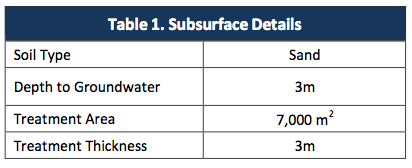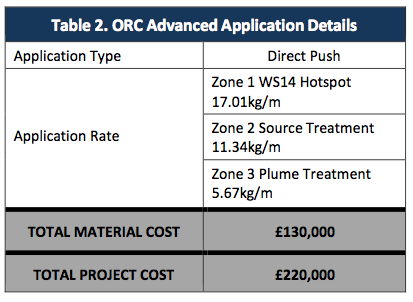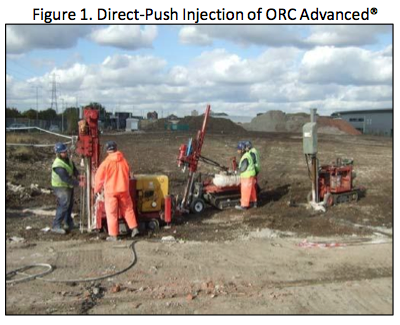Rapid Reduction of Petroleum Hydrocarbons using ORC Advanced® allows for Redevelopment of Site
Summary
Remedial works at the Former Lama Petroleum site were undertaken in late 2008 as part of the ongoing redevelopment of the Fresh Wharf Estate in Barking UK. The site was to be developed for light industrial use, however, historical oil mixing handling and storage activities performed on the site had resulted in TPH and PAH contamination in the groundwater.
Site investigation works suggested the presence of an approximately 1,000m2 source area in thenorthwestern portion of the site, as well as a downgradient plume area, estimated to be in the region of 6,000m2 extending towards the Handtrough Creek. Phase separated hydrocarbons were detected in the source area where the former above ground storage tanks had been located prior to decommissioning circa 2003. In the downgradient plume area, the maximum dissolved phase TPH concentration was 1,100μg/L (Monitoring Well BH102) and located adjacent to Handtrough Creek.


Remedial Strategy
The remedial objective was to reduce dissolved phase concentrations of Total TPH and PAH in groundwater to the agreed remedial target level of 110μg/L, within 12 months of treatment. A trigger level for further remediation was set at 200μg/L, equating to an 80% contaminant concentration reduction within 42 weeks post treatment. If the trigger TPH concentration was not achieved within 42 weeks after treatment, further options would be undertaken.
The original assessment of remedial options identified that a combination of Pump and Treat (P&T) to target free product in the source area and ORC Advanced® treatment in the groundwater plume would represent the most time‐efficient and cost‐effective remedial solution for the site. However, trial pits advanced in the source area during site clearance works

determined that free product was not present in the groundwater, but was present in discrete bands within the unsaturated made ground. Following this observation, excavation to remove the most impacted soils in the source area was determined to be the most suitable approach and P&T was discarded as an option.
Soil removal works were undertaken at the site in October 2008. ORC Advanced treatment in both the source and plume areas was undertaken in October and November 2008. ORC Advanced was applied using three direct push injection rigs and a separate mixing and pumping unit. The rods were driven to 6mBGL and the ORC Advanced was applied over the impacted saturated zone as the rods were slowly withdrawn to 3mBGL. The application included a total of 813 injection points over 19 drilling days. The dose rates were varied to match the different contaminant concentrations and conditions encountered across the site (Tables 1 & 2). Vibro‐piling works were completed across the site at the same time as the ORC Advanced was being applied and were unimpeded by the direct push equipment.
Results
Following the injection of ORC Advanced, a slight increase in the dissolved phase contaminant concentrations was observed due to the site disturbance from injection and piling works. Both TPH and PAH concentrations then rapidly decreased to below the site specific remedial target values and remained low over the monitoring programme. A 99% reduction in the groundwater concentrations of TPH and PAH was achieved with no rebound. Monitoring results are presented below for well BH102, which was located on the southern site boundary, adjacent to Handtrough Creek.

Conclusion
Following the application of ORC Advanced, TPH and PAH concentrations were rapidly reduced and maintained below the site specific target values without contaminant rebound. The works were completed safely and efficiently and did not hinder the ongoing construction works occurring simultaneously at the site. The low final contaminant concentrations and the lack of rebound resulted in regulatory acceptance of the remediation and development works were completed.


 Americas
Americas Europe
Europe Français
Français Deutsch
Deutsch Italiano
Italiano Español
Español


